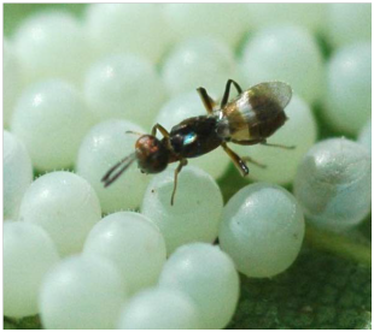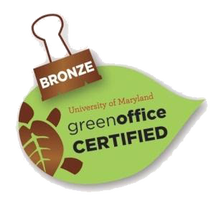|
Post by Lauren Hunt and Thomas Pike On 22 November 2013, we heard MS degree candidate Ashley Jones give her exit seminar in Entomology Colloquium, describing research on indigenous natural enemies of the brown marmorated stink bug (BMSB). BMSB is an invasive species from Asia that arrived in Allentown, PA in 1996 and spread quickly. Now recorded from 40 states, BMBS is an extraordinarily destructive pest of both ornamentals and food crops primarily due to their extremely polyphagous nature. Originally considered merely a nuisance pest, in 2010 BMSB populations exploded, prompting farmers and researchers alike to take action to halt the spread. Biological control is an attractive option, as there are many egg parasitoids and predators in the stink bug’s native range. The goal of Ashley’s research was to determine baseline natural enemy behavior in the US in the hopes that natural enemy complexes could be conserved and promoted to control BMSB. Ashley’s talk focused primarily on the native egg parasitoids of BMSB. During the 2012 and 2013 field seasons, several ornamental tree genera (Acer, Prunus and Ulmus) were checked weekly for eggs. These eggs were then monitored for mortality and parasitoid emergence, which can be seen in this video. Egg mortality was categorized as follows: no mortality, chewing mortality, sucking mortality, parasitism or unascribed mortality (cause unknown). In both seasons, parasitism was the primary source of mortality by a wide margin (32% parasitism in 2012, 44% in 2013). This parasitism increased during the season and was primarily the work of a single genus, Anastatus, which was responsible for 98% of the egg parasitism. Perhaps most intriguing was the change in sex ratio from 2012 to 2013. In 2012, Anastatus reduvii (the most prolific egg parasitoid) had a male:female ratio of 1:2.05. In 2013, this ratio jumped to 1:4.85. Ashley posits that this is most likely due to an increase in eggs available in 2013, encouraging the parasitoids to produce more females to exploit this resource. Ashley concluded that predation by various common nursery predators did seem to augment control of the BMSB. She observed a distinct pattern in the way the predator density and the stink bug infestation were related. As the number of stink bugs decreased in the season, so did the number of predators observed. Likewise, as the number of stink bugs present increased, the number of predators rose with slight delay, compensating, it seems, for the increase in food availability. This pattern was consistent in both years she ran the study. In the laboratory, Ashley used feeding trials to determine which natural enemies were the most successful at control. She conducted trials on wheel bugs, jumping spiders, lacewings, minute pirate bugs, convergent lady beetles, and multicolored Asian lady beetles. Across all life stages of BMSB, wheel bugs were most voracious by far. The lab BMSB egg trials, however, did not show what was clearly demonstrated in field observations. No predators consumed the eggs in these trials, even though lacewing larvae had been observed feeding on BMSB eggs throughout the summer. This may be attributed to a different species of lacewing used in lab trials compared to what is found in the field setting. Remaining unanswered and open for additional investigation is the occurrence of unascribed mortality, in which the BMSB eggs did not hatch and died, with causes unknown. Could this arise from feeding by adult parasitoids? A fungal pathogen, perhaps? A byproduct of a feeding predator? Because unascribed mortality was more common with larger egg clutch sizes (density dependent), this tends to favor a biotic hypothesis over, for instance, extreme temperature, the effects of which should not differ with egg density. The more information we have, the more possible research avenues become available to learn how to best control these pests in an environmentally safe and sustainable manner. Ashley suggested further research is needed on the main species of parasitoid found successfully controlling BMSB in ornamentals and nurseries, Anastatus reduvii. Although we know Anastatus is a generalist parasitoid, we know relatively little about other factors that may directly influence its longevity and fecundity. By gathering more information about this promising biological control agent, it might be included as a component of an Integrated Pest Management (IPM) program to control these pesky stinkers in our nurseries, gardens, and homes. About the authors
Lauren Hunt is a first year Master’s student conducting research focused on biological control of stink bugs, with emphasis on the usage of insectary plants to increase mortality of the invasive brown marmorated stink bug (BMSB). With exponential human population growth, there is an intensifying need for all varieties of sustainable living practices, including food and grain production. She is interested in the development of techniques that will conserve natural resources and biological living systems. Thomas Pike is a second year Master's student studying the effects of entomopathogenic fungi on the brown mamorated stink bug with regards to its use as a formulated biocontrol. He is also pursuing trap-and-kill systems utilizing BMSB pheromones and the fungus to be used as a passive control. These control methods show promise as an alternative to current pesticide use in ornamental and crop systems. Comments are closed.
|
Categories
All
Archives
June 2024
|
Department of Entomology
University of Maryland
4112 Plant Sciences Building
College Park, MD 20742-4454
USA
Telephone: 301.405.3911
Fax: 301.314.9290
University of Maryland
4112 Plant Sciences Building
College Park, MD 20742-4454
USA
Telephone: 301.405.3911
Fax: 301.314.9290



 RSS Feed
RSS Feed




